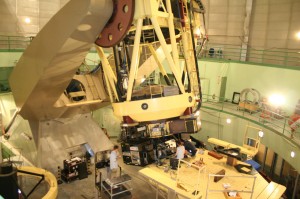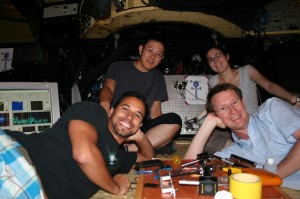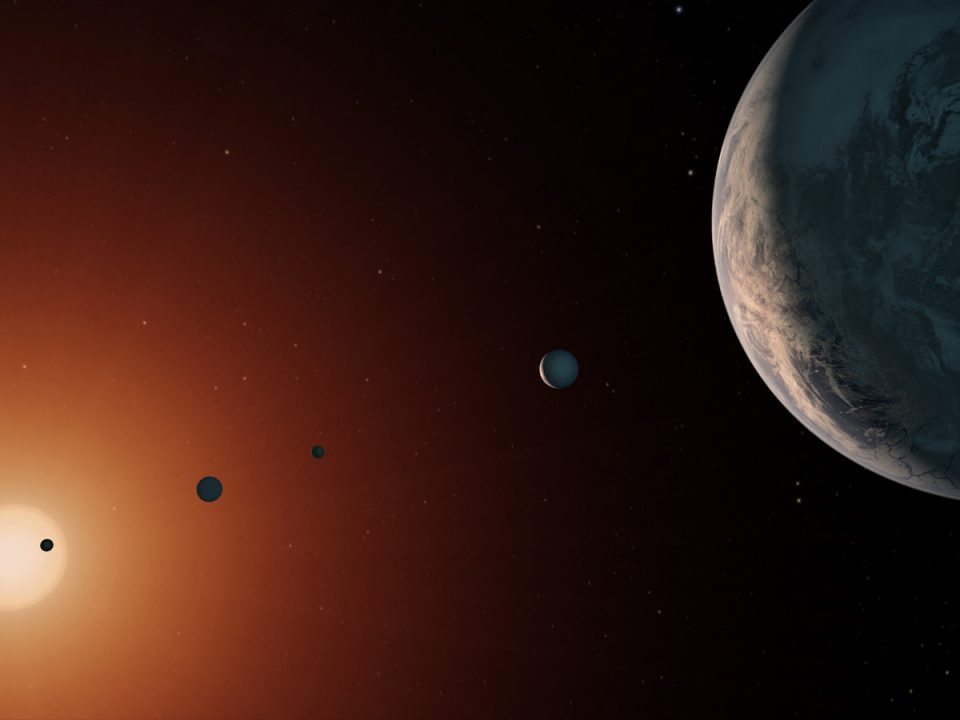FIRST@LICK: Getting ready for the first night
FIRST@LICK: Mounting of the prototype
August 3, 2010FIRST@LICK: first photons from a star
August 9, 2010After a complicated mounting of the instrument on the telescope, we spent the entire first 2 days and a large part of the beginning of the night, reinstalling and realigning the FIRST instrument. JUly 23 and July 24 were busy days with zillion of problems to solve. I am going to share you the “joy” of instrumentation in this post.

My colleagues (Guy Perrin on the far left, Elsa Huby and Takayuki Kotani on the platform) working on getting ready the FIRST prototype for the first Night (July 24-25)
This picture above summarizes in a few words our first day which started at 9am. Guy Perrin and myself were in charge of installing all the control electronics on the telescope in the racks located on both side of the adaptive optics system (which is inside the black box at the bottom of the telescope). Elsa Huby and Takayuki Kotani reinstalled and realigned all the optics and microelectronics on the FIRST optical bench (the gray table in front of them). While taking this picture, I realized how lucky we are to be able to access to this large telescope and to install ourselves this kind of instrument. Even if the Lick Shane is “only” a 3m telescope (aka equipped with a 3m-diameter primary mirror), we already seem tiny in comparison with the size of the telescope on this picture, what will it be with a 30m telescope like the TMT or the E-ELT?
A picture illustrating the difficulty of installing and aligning optics and micro-electronics elements on the vertical table of the FIRST prototype.
If the image does not display try this link:
http://www.cosmicdiary.org/fmarchis/files/2010/08/aligning1.jpg
We realized that we under estimated the difficulty of installing and aligning fragile and heavy optics or microelectronic elements on a vertical optical table like the FIRST prototype. This table is in an unusual vertical position because it is attached on the adaptive optics table which is per design already vertical, so we had no choice. A large part of the first day was dedicated in making sure that the heart of the injection system was properly mounted and aligned. We use a small scale micro-electro-mechanical (MEMS) developed by IRIS-AO. Each of the 37-elements is precisely aligned with one fiber in an optical fiber bundle. We use the segment tip-tilt to inject the light into the 8-um fiber core. This is the crucial part of the FIRST instrument since a partial or unsuccessful injection will limit the potential of the system.
For the specialist only: We spent the second day installing a flat mirror on the adaptive optics system to intercept the beam on the AO system and send it to the FIRST prototype. We realized that there were 2 major issues with our current design: 1. this flat mirror intercept the path before the AO analysis meaning that we will have to work without AO and thus poor quality imaging. 2. the focal point of the telescope is shifted by 25 cm, meaning that we had to improvise and extend the light path by 25 cm on the FIRST table.

Takayuki Kotani, Elsa Huby, Franck Marchis and Guy Perrin in front of the FIRST prototype at Lick Shane 3m telescope. Ready to go on the sky!
We took the picture above at 9pm on July 24 after an intensive day of work. We have several reasons to be happy and smiling on this picture. As you may see on the computer screen located behind me (left), the system was then aligned and using a laser red source we could have interferences fringes. Even if we use an artificial source or this purpose, it was the first time we obtained these fringes using the adaptive optics laser beam, so we solved the issue 2 mentioned above.
Before starting the night, we had to attached all the cables on the telescope, clean up the platform, prepare the telescope, set up the VNC server to control the instrument comfortably from the Shane control room. We were ready to move to the control room at 4am PDT!
more tomorrow….


